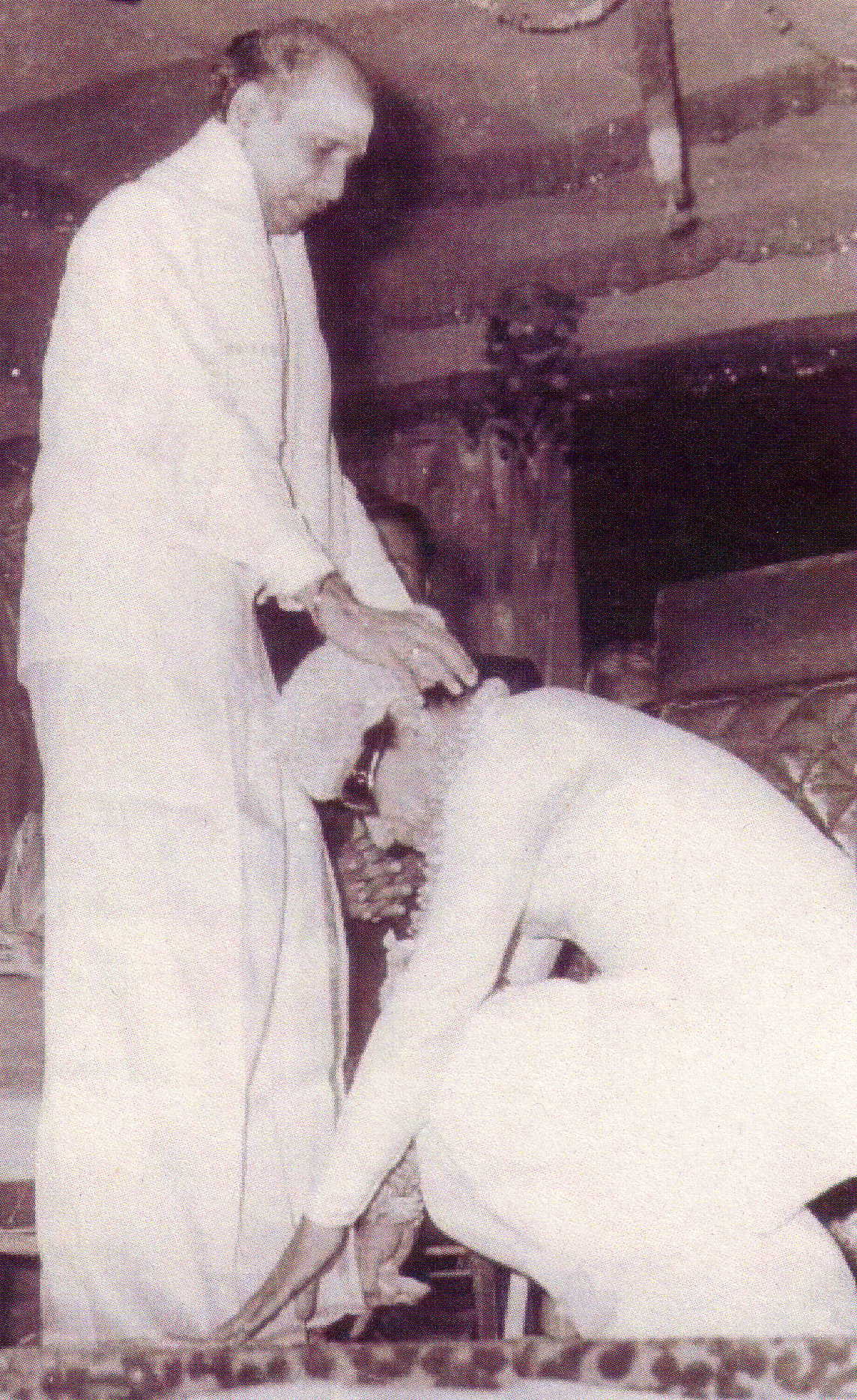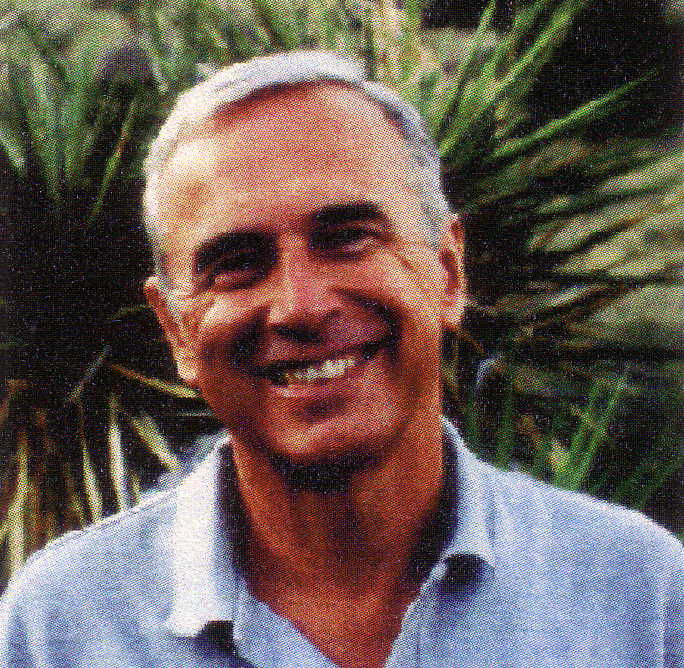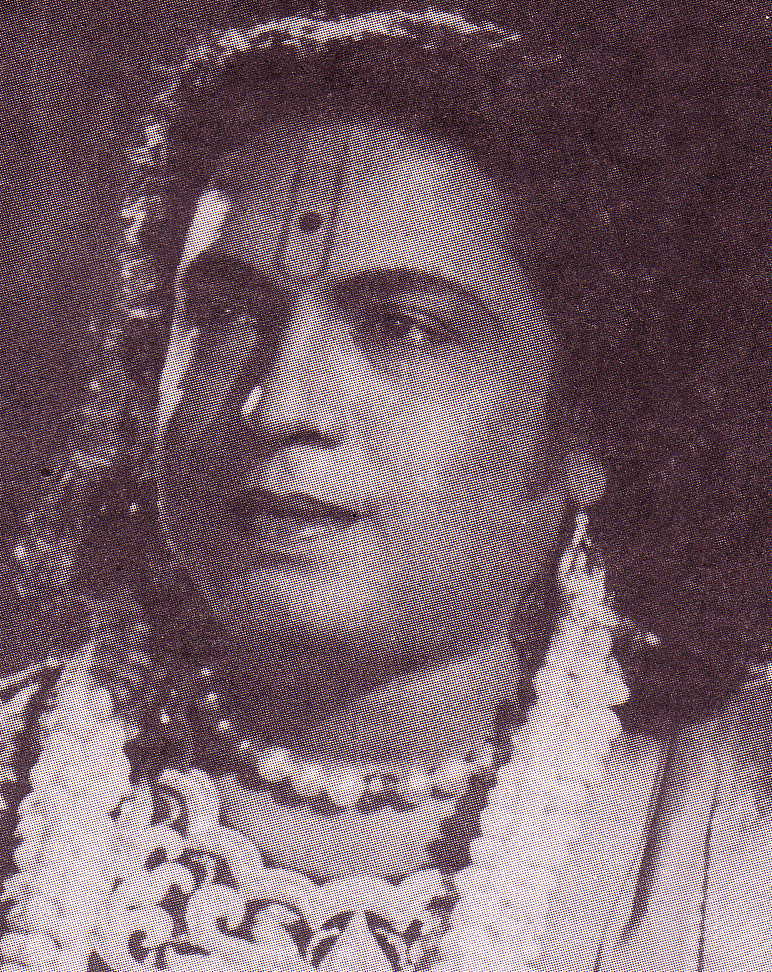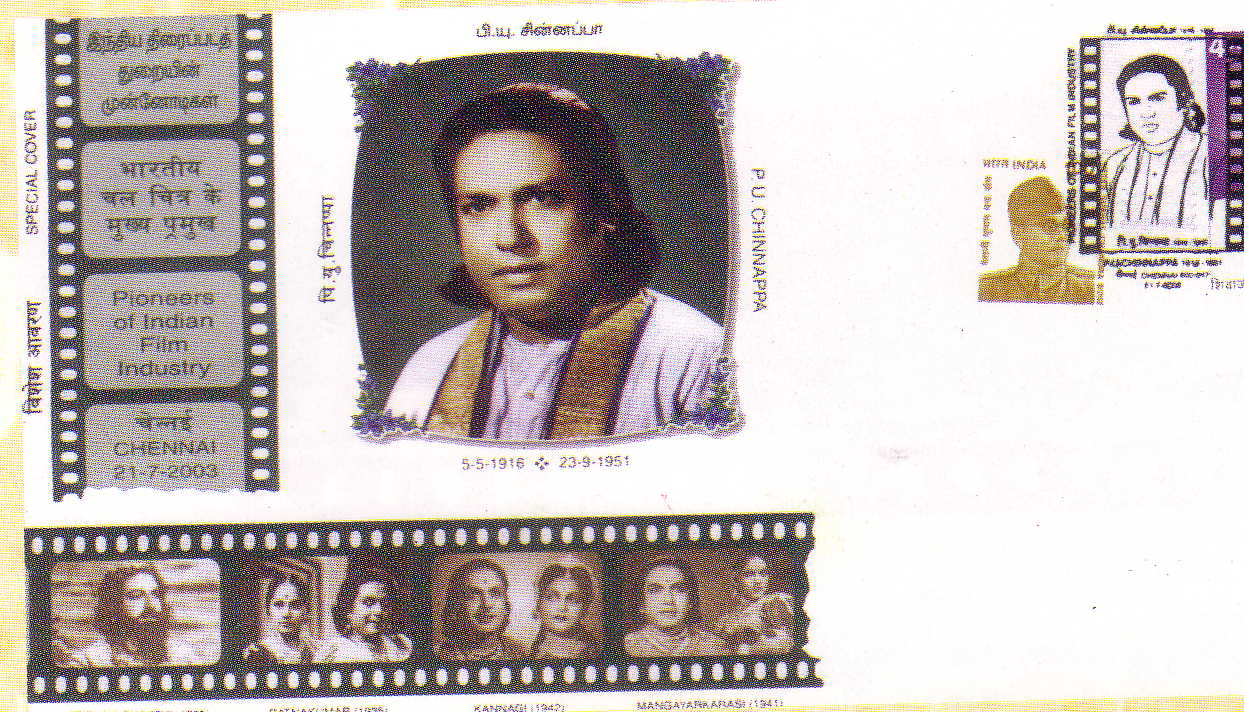by Sachi Sri Kantha, November 1, 2013
One Dilemma of Biographers
Few biographers begin the biography of their subjects, immediately from the date of birth. Here are some examples:
Ernest Jones began his ‘Sigmund Freud: Life and Work (vol.1, 1953) with, “Sigmund Freud was born at 6:30 pm on the six of May, 1856, at 117, Schlossergasse, Frieberg, in Moravia, and died on the twenty third of September, 1939, at 20, Maresfield Gardens, London.”
M. Vythilingam, opened his ‘The Life of Sir Ponnambalam Ramanathan (vol.1, 1971), with the following sentence: “Ramanathan was born on 16th April 1851 at what is known today as Sea Street, Colombo in the stately home of his illustrious grandfather Gate Mudaliyar Arumuganathapillai Coomaraswamy, the first occupant of the Tamil seat in the Legislative Council, when it was newly constituted under the British in 1833”.
MGR greeting M.K. Radha in a public function

Martin Green’s opening sentence of his ‘Gandhi: Voice of a New Age Revolution’ (1993) was, “Mohandas Karamchand Gandhi was born on October 2, 1869, in a three-story house in Porbandar: which is a town on the Arabian Sea Coast of India, north of Bombay, in the province of Gujarat.”
Brenda Maddox began her, ‘Rosalind Franklin – the dark lady of DNA’ (2002) with, “The family into which Rosalind Elsie Franklin was born on 25 July 1920, stood high in Anglo-Jewry.”
But, not all biographers have such a luxury in beginning their biographies of subjects. Such a beginning is possible, if a validated birth certificate exists for the biographical subject. What if, such a document is unavailable for any reason, and the conditions of birth are shrouded in mystery? Not only the date of birth, but even the location of birth couldn’t be clearly deciphered for many legendary individuals, due to family circumstances of temporary residence and migration.
A good example I located among the biographies I had read was that of ‘Saint Peter’ (1994), by Michael Grant. He began his first chapter entitled ‘The Problems of Research’ with three sentences as follows: “Peter is one of the central figures of the Christian religion and also, inevitably, a key figure of the entire world of today, with which, whether people are aware of the fact or not, that religion is inextricably fused. And yet he remains a shadowy, legendary personage. Some declare, indeed, that it is impossible to recover any true picture of him and see what he was really like.”
At least, we have a chronological excuse that Saint Peter lived almost 2,000 years ago. So, we don’t know exactly when and where he was born. But historians had deduced that Peter was probably executed in Rome, between the years AD 64 and 68. For MGR, who lived amongst us until 26 years ago, we are not sure when and where (I mean, the exact location) he was born! Of course, he himself had acknowledged that he was born in Ceylon. Some reports identify the location as either Kandy or Nawalapitiya. But, we know certainly that MGR had a natural death on December 24, 1987 in Chennai. As such, I refrained from beginning the first part of this biography with information about his birth date. But, I cannot let this inconvenience pass forever. I was determined to settle tentatively, MGR’s date (or at least) year of birth, from circumstantial evidence.
Help from Two Specialists
After I began writing this ‘MGR Remembered’ series, I was fortunate to contact two specialists via emails. One was Emeritus Professor Robert Hardgrave Jr. (born 1939). He was one of the pioneer American academics who focused his attention on the Tamil Nadu politics of 1960s, and is considered as an authority on DMK of Anna period and Nadar caste. The other one was R. Kannan (born 1962), a biographer of C.N. Annadurai, the leader of DMK. He is from Chennai. In fact, Kannan is also currently writing a biography on MGR. When Kannan contacted me after reading this MGR series, rather than treating Kannan as a rival for my interests, I was happy to share whatever I had collected on MGR with him, and he also had reciprocated equally. One of the gifts I received from Kannan, was a photocopy of MGR’s published autobiography ‘Naan Yen Piranthaen’ (2003). I had valued this gift from Kannan, because for the past 40 years, it had remained as one of my elusive needs. Having received this vital document, I set upon to settle the doubts on MGR’s year of birth.
Here is what, Prof. Hardgrave had written about MGR’s early years, in 1979. “M. Gopala Ramachandran is a Malayalee, born in Kandy, Ceylon, where his father was the principal of a college. His official birth date is January 17, 1917 – although it is widely believed that he is really five years older. When MGR was three years old his father died, and the family moved to Tamil Nadu. Poverty-stricken, his two sisters and a brother died. At the age of six, MGR entered ‘the Madurai Original Boys Company’, a dramatic troupe.”
Prof. Hardgrave had given me permission to cite the email exchanges he had with me, on MGR-related queries. I provide four of the recent email exchanges which I had with Prof. Hardgrave.
Dear Prof. Hardgrave,
Today, I received the reprints and photocopies of your 5 publications on MGR-DMK-Tamil movies. I’m so delighted. Thank you very much for your kindness. In 1970s, your name was the first among American scholars I recognized for your studies on Nadars. I had been wondering since then, what made you interested in researching on Tamilians. I cannot belief that now, I’m corresponding with you via email.
I recognize that you had interviewed MGR in December 1969. Now that he had died for 25 years, may I know some of your impressions about him. For example, (1) Did both of you talk in Tamil, or in English? (2) If you talked in English, was he able to comprehend your questions properly? (3)You mention that though his official birth date is given in 1917, it was recognized that he was born 5 years older. Did you check with him directly, about his birth year? (4) After your publications were printed, did you send these to him, and what were his reactions? – Did he bothered to express any? (5) Did you take any photo with him? Sorry for troubling you with these questions. I was lucky, only to shake his hand for a second in 1981 at Madurai. That’s my brief interaction with him. Hence, these questions to you. Best regards.
Sachi
Sept. 28, 2013: from Robert Hardgrave Jr.
Dear Sachi,
I had become interested in India when an undergraduate, and for a Senior Honors Thesis, I selected a political party–the DMK–I had read about but for which there were not scholarly articles. I was curious, and I was able to my thesis from microfilm sources of “The Hindu” and other Tamilnadu newspapers. It was limited, but it got me interested in Tamil politics, and I was able to get a Rotary International Scholarship to spend a year in India, 1960-61, before I started my graduate studies for my M.A. and Ph.D. at the University of Chicago. I divided my stay in India between Madras and New Delhi. I decided to give some focus to my time in India by extending my study of the DMK-and since no one had studied it before, I was welcomed by party leaders. I met all of the leaders, but it was E.V.K. Sampath (at that time, the DMK’s only Member of Parliament, and a nephew of Periyar) who became my friend and mentor. At that time, MGR was more focused on film than on political life–but his films, of course, had a DMK theme.
My M.A. thesis at the University of Chicago was “The Dravidian Movement,” drawing on all the interviews I had conducted with DMK leaders and others when I had been in India, as well ask a huge number of DMK and DK publications I collected. The thesis was published as a book in 1965.
I studied Tamil at the University of Chicago and used it in my Ph.D. dissertation research on the Nadars. My next research project, in 1969-70, took me back to Tamil Nadu and to my continuing interest in the DMK for a study of politics and the Tamil film. I had met Sivaji Ganesan earlier, and I spent a good bit of time with him and got to know him quite well. While I talked with many of the people associated with MGR and had special screenings for me at studios of old MGR films, I interviewed him only once. I attended meetings where he was present, but I really talked with him on one (may be two) occasion. He was not really comfortable speaking English, but as I recall, most of our conversation was in English-perhaps with some Tamil. I do not recall any discussion of his birth year, but he was known to be very sensitive about his age–especially as he still played romantic roles where he was supposed to be a young man pursuing his love interest. I wish I had gotten a photo of me with MGR. That would be a treasured memento.
There are so many stories of MGR helping people, but I know of one family (with whom I remain close friends) that he helped greatly when they faced a financial crisis. They remain forever grateful for his generosity.
Several years ago, when Theodore Baskaran was director of the Raja Muthiah Research Library in Chennai, I gave copies of all my film project interviews and also my collection of photos and film posters, and film-related pamphlets, publications, etc. to library.
I wish you all the best on your project. Yours, Bob
Sept. 29, 2013: from Sachi Sri Kantha
Dear Prof. Hardgrave,
Thanks a lot for responding to my questions. May I ask your permission to quote the contents that you have stated, in my ‘MGR Remembered’ series. In my opinion, provided details seem to hurt no living individuals. You can glance at my latest chapter on this series, part 11 by the link provided below.
sangam.org/mgr-remembered-part-11/
Best regards.
Sachi
Oct. 1, 2013: from Robert Hardgrave Jr.
Dear Sachi,
You may quote me. Thank you for including the URL for the Ilankai Tamil Sangam site and your “MGR Remembered.” It is very interesting, and I will share it with a few people who I know will be interested. All the best, Bob.
The entry on MGR in the Encyclopaedia of Indian Cinema (1999), while indicating the birth and death years as 1917-87 next to his name, carries an erroneous indication in the second sentence: “Born in Kandy, Sri Lanka (possibly in 1912)”. It is my opinion that the birth years of other well-known Tamil movie stars such as Sivaji Ganesan, N.S. Krishnan and P.U. Chinnappa are erroneous in this encyclopedia. Such errors reflect badly on the fact-checking skills of Tamil film historians (Randor Guy, M.S.S. Pandian, S. Theodore Baskaran, Preetham Chakravarthy and M. Ravikumar) who had acted as consultants for this encyclopedia. Not only this. Even some other Tamil movie artistes who had received entries in this encyclopedia are devoid of information about their birth years. Due allowance should be made that film industry personnel, beginning from starlets and heroines, are notorious for hiding such vital information from snooping reporters.
Previously I have written an essay on ‘Anna, Annachi, Annathe’ on the endearing kinship word in Tamil, as a 80th birth anniversary tribute to singer Sirkazhi Govindarajan. In it, I also included the variant term ‘Anne’ (in Tamilnadu) or ‘Annai’ (in Eelam). Literally, the word means elder brother. So, I checked in MGR’s autobiography to count the number of individuals for whom MGR had used this special kinship term among his drama-cinema circles. The logic was, he couldn’t have used this term for one who was born in the same year as he was, or to anyone who is younger to him. If I could establish clearly, the year of birth of at least one individual for whom MGR had addressed as ‘Annan’ or ‘Anne’, then he would have been chronologically junior to him.
Here is the list of 14 individuals MGR had used ‘Anne’; some are well known, but others are not so well known. Most of them were his mentors and actors in stage and/or cinema. Unfortunately, I don’t know the exact year of birth of all these 14 individuals. But, the birth years of few among the well-known personalities have been helpful.
Madras Kandaswami Radha (1910-1985), mentor and actor
Mannarkudi G. Nadaraja Pillai, actor
Kali N. Ratnam, mentor and comedian actor
T.R. Ragunath (1912-1990), director and younger brother of Raja Chandrasekhar, director.
Puthukoddai Ulaganathan Chinnappa (1916-1951), mentor and actor
Nagarkoil Sudalaimuthu Krishnan (1908-1957), mentor and comedian actor
Ramadas, makeup man
K.P. Kesavan, mentor and actor
K.P. Kamatchi, actor and lyricist
Sama Naidu, friend
T.K. Shanmugam (1912-1973), actor
Madras Rajagopalan Radha (1907-1979), actor
Sunthararaju, scene ‘set up’ man in dramas
K.K. Perumal, actor
Of the five mentors of MGR listed above, who appear prominently in his autobiography, I’m not sure about the birth years of Kali N. Ratnam and K.P. Kesavan. But, the birth years of other three mentors (namely, M.K. Radha, N.S. Krishnan and P.U. Chinnappa) are certain.
A heart-warming photo exists of an aged MGR (in his fur cap and sun glass) greeting his older mentor M.K. Radha (whose father Madras Kandaswami Mudaliar was the provider for young MGR and his elder brother Chakrapani as a drama company proprietor) by bending his knees to touch the feet of his mentor, in a public function. Charismatic MGR was a stickler for decorum and seniority. His assistant K. Ravindar had recorded in his memoir that MGR would be irritated with those juniors (actors or assistant directors) who failed to maintain proper decorum, like crossing one’s legs while seated when a senior passes by. Those who commit such blunders would be instantly fired from their jobs! Such a personality like MGR, bending his knees to touch the feet of an older M.K. Radha tells something about the respect he had for his mentor.
Raja Chandrasekhar (1904-1971) was the director for a few of early MGR movies, when MGR played bit parts. Here is what MGR had written about the magnanimity of M.K. Radha (MKR) in his autobiography.
“Mr. MKR took me to Mr. Sekhar. Dakshayagnam was about to be produced. [It was MGR’s third movie, released in 1938]. He took me to recommend me for a spot in that movie. Director Sekhar asked: ‘Why Radha? Can Ramachandran act?’
Mr. M.K. Radha Annan replied: ‘Why, you are asking like that? What do you think about me?’
For this response, Mr. Sekhar retorted, ‘When I’m asking about him, you are telling about yourself.’
MKR smiled and responded, ‘What answer you provide about me, will be the same answer I give about Ramachandran.’ MKR didn’t stop there. ‘I have luck. So I act as hero. Ramachandran is down on luck. So, he is looking for opportunities. The difference between us is this. There is no other difference, in acting or other capabilities between us.’
This is how, M.K. Radha Annan responded, to solicit a chance for me. When I’m writing this, I cry. I’m not sure whether you cry or not. About my capabilities, none haven’t talked like this before; or even later, as of now. Friends do put me down, but to find me an opportunity, the kind M.K. Radha Annan exaggerated about my talent so much then. I’ve never come across any other actor like him.”
Akin to M.K. Radha, MGR also formed a solid mentor-protégé link with P.U. Chinnappa. His autobiography provides many episodes about his interaction with P.U. Chinnappa as well. Especially of interest to me was the birth year of P.U. Chinnappa, about whom I had written in previous parts. I did write, it was the untimely death of Chinnappa in 1951, which opened up MGR’s path for hero roles in Tamil cinema. Ten years ago, a stamp was released for Chinnappa in India, as one of the pioneers of Indian film industry. In it, it is recorded that his birth is recorded as 1916 May 5. Thus, by deduction, MGR should have been born after 1916, to address him as ‘Anne’. Therefore, it is safe and sound to infer that MGR was indeed born in 1917. When I wrote a 82nd birthday tribute to MGR in 1992 in the Tamil Nation (print edition), I wrote the following:
“Many have ridiculed the uncertainty of his birth date, though MGR had used 17 January 1917 in his personal documents. One should sympathize with MGR on this matter because he was born to an Indian immigrant family in a tea plantation in Ceylon, which was then under British colonial rule. Way back in 1917, the health care facilities available for the plantation workers were atrocious, leave alone the requirements related to birth registration. That he survived into adulthood itself was an achievement.”
Now, I feel relieved that having read MGR’s complete autobiography, by deductive inference, I can safely assume that 1917 as his birth year cannot be in error.
It is interesting to note that in his autobiography, MGR addressed his own elder brother Chakrapani (1911-1986), as ‘Yetan’, and not as ‘Annan’. Wherever he mentions his brother, he used another honorific Tamil word for elder brother, ‘thamayanar’. As Chakrapani was born to Gopala Menon and Satyabhama in 1911, at Vadavanur, Kerala state, it can be assumed that MGR’s parents immigrated to Ceylon, only after Chakrapani’s birth – probably tempted by suitable job opportunities available then for Gopala Menon. We don’t have information on which year MGR’s parents moved to Ceylon. In the last chapter (No. 134) of his published autobiography, MGR does mention that he was born in Ceylon, and was brought up in Tamilnadu. It is unfortunate that his autobiography was abruptly abandoned (akin to quite a number of his movie projects), immediately after his expulsion from the DMK party in October 1972.
How can one answer Robert Hardgrave’s comment in his 1979 paper that “His [MGR’s] official birth date is January 17, 1917 – although it is widely believed that he is really five years older.” Until he reached 50 in 1967, MGR was a virile, action hero. He protected his trim physique by performing rigorous exercises. Only after he received gunshot wounds from his senior actor M.R. Radha in 1967, MGR appears to have aged noticeably. Yet, he was still in demand by the producers and film distributors to play hero role. Maybe, like any other movie industry in other countries, the ‘industrial air’ is bound to circulate rumors spread by rivals who were focused in tripping the glamor of a popular hero. MGR was no exception. He did have powerful rivals in cinema, politics and print media who spread incorrect facts for profit.
Think of a situation that if MGR was indeed five years older, then he should have been born around 1912, as indicated in the Encyclopedia of Indian Cinema. This would make MGR older than P.U. Chinnappa, whose birth year is certified as 1916. If MGR addressed Chinnappa as ‘Anne’, then Chinnappa should have been born before 1912! This in turn would make the fact provided in the Indian stamp released in honor of Chinnappa as erroneous.
There is another supporting statement from MGR in his autobiography. He does mention, “When I entered cinema, I was around sixteen or seventeen. Even then I had a well- proportioned body build.” (chapter 10, p. 136). Suppose MGR was born in 1912, then accordingly, he would have entered cinema either in 1928 or 1929. This couldn’t be true. This is because, the first Tamil-Telugu bilingual talkie movie Kalidas was released only in October 31, 1931. And MGR would have spent over six years in cinema, before the release of his debut movie in 1936.
Sources
Randor Guy: Fame eluded this sibling of an icon. The Hindu (Chennai), Feb.16, 2012. [a brief profile on M.G. Chakrapani’s career]
Robert L. Hardgrave Jr.: When Stars displace the Gods: The Folk Culture of Cinema in Tamil Nadu. In: Essays in the Political Sociology of South India, New Delhi, Usha Publishers, 1979, pp. 92-124. [originally appeared as, Occasional Papers No.3, Center for Asian Studies, University of Texas at Austin, 1975].
MGR: Naan Yen Piranthaen [Why I was Born?], Rajarajan Pathipakam, Chennai, 2003. Part 1 (696 pages), Part 2 (697-1396 pages). [in Tamil]
Ashish Rajadhyaksha and Paul Willemen: Encyclopedia of Indian Cinema, new revised edition, Oxford University Press, Oxford, 1999, pp. 187-189.
K. Ravindar: Pon Mana Chemmal MGR [Golden Hearted MGR], Vijaya Publications, Chennai, 2009, pp. 104-105. [in Tamil].



Extensively researched
Well done
I’m staying tuned for more from you esp on MGR
Thank you
Adi
Dear Sir/Madam,
Please alert me when new articles about MGR Remembered are posted.
Thank you.
Sachi Sir
This comment is with regard to the recent Bharat Ratna Award by Government of India to Prof CNR Rao (a famous Indian Chemist ) .Being a Science Professor yourself and also having got your Doctorate in Chemistry related subjects you must aware of Dr.C.N.R.Rao and his works and publications . Would love your feedback on the Contributions of Dr.C.N.R.Rao .